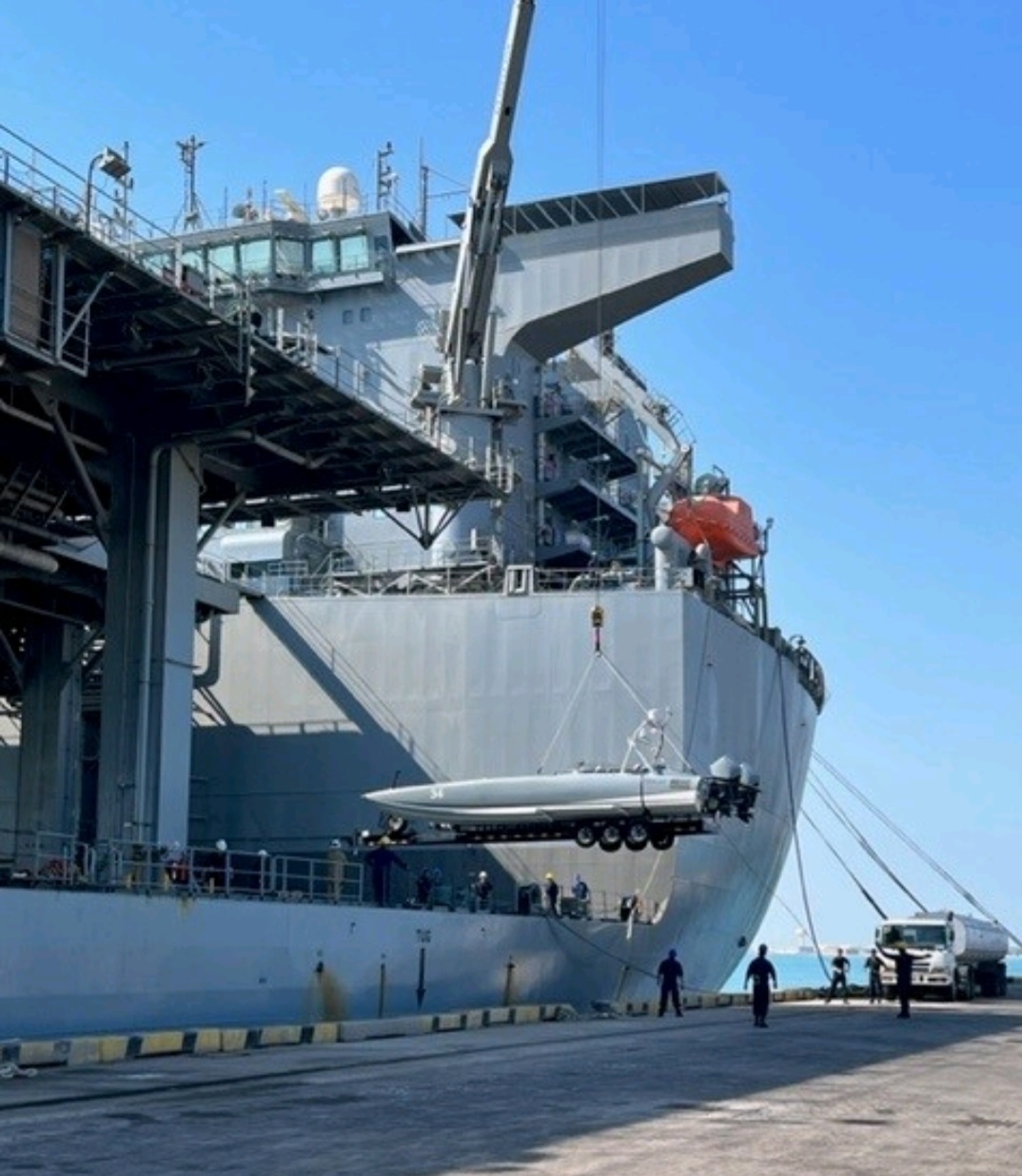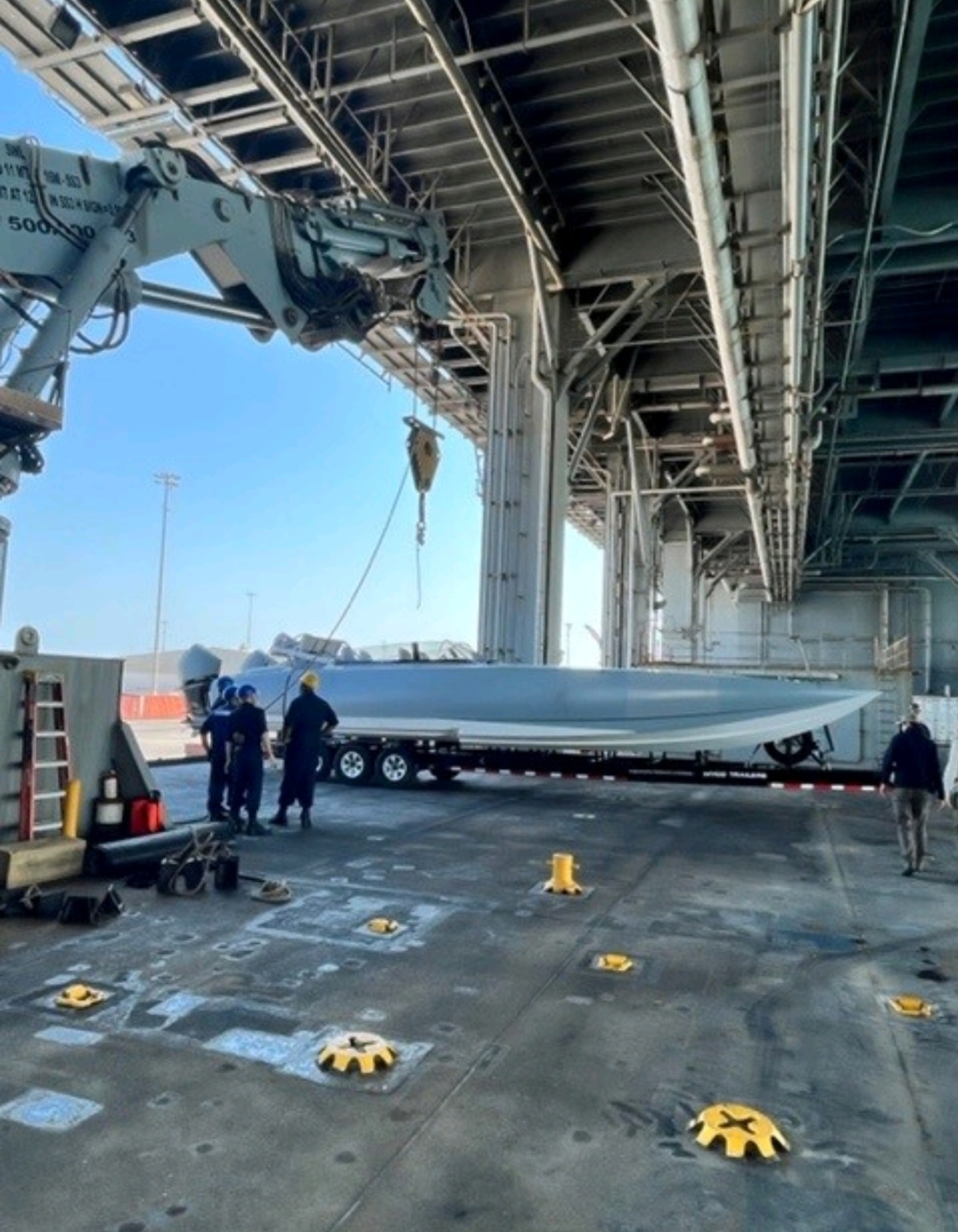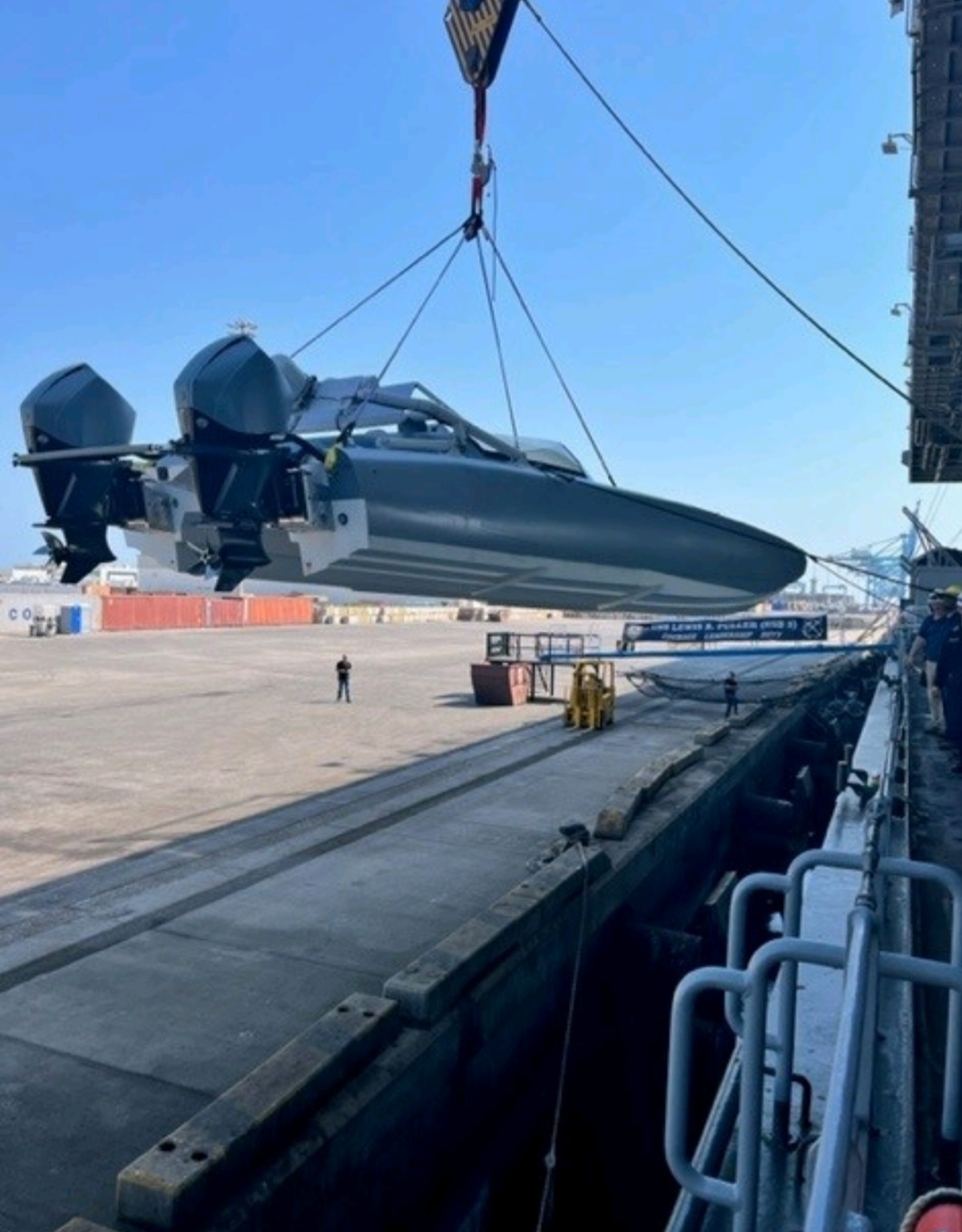We have just published our book A Maritime Kill Web Force in the Making which highlights how mobile and sea basing provide key components for an integrated distributed force.
As we noted in the chapter in the book entitled “the expeditionary sea basing force in maneuver warfare”:
“The U.S. Navy will never have enough ships to dominate as it did in World War II with the strike force that hit Saipan. And with the naval build-up of the Chinese and the Russians, the threat envelope is expanding at the same time. This means that the U.S. Navy will need to get full value out of the ships they have and to leverage flexible basing options in maritime maneuver warfare, shape enhanced integratability with the USAF and find more effective ways to operate with allies and partners.
“Shaping an integrated distributed force for maneuver warfare at sea, operating through interactive kill webs, is not a nice transformation to have but a requisite one. There is no area where better value could be leveraged than making dramatically better use of the amphibious fleet for extended battlespace operations.
“This requires a re-imaging of what that fleet can deliver to sea control and sea denial as well as Sea Lines of Communication (SLOC) offense and defense.
“Fortunately for the sea services, such a re-imaging and reinvention is clearly possible, and future acquisitions which drive new connectors, new support elements, and enhanced connectivity could drive significant change in the value and utility of the amphibious fleet as well. In addition, as the fleet is modernized new platform designs can be added to the force as well.
“This entails shaping variant payloads as well to be delivered from a distributed integrated amphibious fleet. As building out the evolving fleet, larger capital ships will be supplemented and completed with a variety of smaller hull forms, both manned and autonomous, but the logistics side of enabling the fleet will grow in importance and enhance the challenges for a sustainable distributed fleet.
“That is certainly why the larger capital ships – enabled by directed energy weapons as well – will see an enhanced role as mother ships to a larger lego-like cluster of smaller hull forms as well.”
Recently, I continued my discussions with Jim Strock, a leading expert on expeditionary sea-basing, about how such an approach is enabled by the new class of expeditionary sea-basing ships, the Lewis B. Puller-class expeditionary sea base ship.
But prior to focusing on that discussion, here is a very good explanation of this class of ship provided in a June 16, 2020, video where the captain of USS Lewis B. Puller explains how this ship contributes to the enablement for the force operating from a sea base.
And this is how Naval Sea Systems Command describes the ESB:
“The Expeditionary Sea Base (ESB) ship class is highly flexible that may be used across a broad range of military operations supporting multiple operational phases, similar to the Expeditionary Transfer Dock (ESD) class. Acting as a mobile sea base, they are part of the critical access infrastructure that supports the deployment of forces and supplies to provide prepositioned equipment and sustainment with flexible distribution.
“The ships were originally called the Mobile Landing Platform (MLP) and the MLP Afloat Forward Staging Base (AFSB), respectively. In September 2015, the Secretary of the Navy re-designated these hulls to conform to traditional three-letter ship designations. The design of these ships is based on the Alaska class crude oil carrier, which was built by General Dynamics National Steel and Shipbuilding Company (NASSCO). Leveraging commercial designs ensures design stability and lower development costs.
“The USS Lewis B. Puller (ESB 3), USS Hershel “Woody” Williams (ESB 4), and follow on ships USNS Miguel Keith (ESB 5), John L. Canley (ESB 6), and Robert E. Simanek (ESB 7) are optimized to support a variety of maritime based missions, including Special Operations Forces (SOF) and Airborne Mine Counter Measures (AMCM). The ESBs, which include a four spot flight deck, mission deck and hangar, are designed around four core capabilities: aviation facilities, berthing, equipment staging support, and command and control assets.
“In August 2017, upon arrival in the U.S. 5th Fleet Area of Responsibility, ESB 3 was re-designated from USNS and commissioned as a USS. As a commissioned Navy ship, USS Lewis B. Puller (ESB 3) is commanded by a Navy O-6 with a permanently embarked military crew. This re-designation provides combatant commanders greater operational flexibility as to how the platform is employed in accordance with the laws of armed conflict.
This is how Strock then described how the ESB can operate to support an integrated distributed fleet and deliver kill web capabilities.
“Let me give you an overview of what the ship can do in its current configuration and with potential modifications. Right now, it has inherent features that can support Marine Corps MAGTF capabilities and mission sets in the near term. Its current organic capabilities support aviation, troop movement, equipment staging, and have significant command and control spaces.
“And it has already demonstrated the ability already to embark and operate a wide variety of modular capabilities for mission tasking well beyond what the ship was originally designed to do.
“For example, it provides for unmanned systems operation and support. As you know, the Navy and the Marine Corps are considering adding unmanned surface vessels, unmanned under sea vehicles, and unmanned aerial vehicles as fundamental capability sets in current and future operating environments.
“They’re already out there. Once operational, those systems need to be supported without encumbering other high-value ships, such as surface combatants and amphibious ships with additional duties.
“The ESB in its current form and with modifications could support a wide variety of surface, aerial, and undersea unmanned systems to include launch and recovery, fueling, repair, and data and information fusion, as well as unmanned aerial systems that could be employed as airborne repeaters.
“The latest ESB that is under construction and will be christened on 25 June in honor of the late Sergeant Major John L. Canley, USMC, has a new boat davit launch and recovery system made by Vest Davit. This system can launch and recover surface craft up to 20-ton weight, a significant increase in the ship’s lift-on, lift-off capabilities
“Another capability which the ESB can provide is to operate as an alternate aviation operations and support platform. The ESB has the third-largest flight deck in the Navy’s inventory. The flight deck and hangar are currently certified to support H53, H60, V22, H1 aircraft operations. It’s currently operating unmanned aerial systems off of the flight deck. It’s able to enhance the ARG by providing increased aircraft operating spots and maintenance support services.
“For example, selected ARG aviation elements originally embarked on amphib ships could be transitioned to the ESB, thereby enabling the ARG’s large deck amphibious ship to be configured as an F-35 lightning carrier, if required. And as you know, the USS Tripoli just completed that test of a pure JSF mix.
“Moreover, the ESB has more than sufficient space, weight, and power reservations to accommodate the installation of ship modifications and enhancements that would enable the launch recovery of F-35 aircraft in vertical takeoff mode and landing mode, along with selected maintenance and support requirements.
“There is interest in determining whether or not you could modify one of the operating spots on an ESB to support JSF pure vertical launch and recovery. That would mean that a JSF, without armament and without full fuel load, could hopscotch to and from a big deck, if you needed to cross deck the airframes.
“What is not known right now is whether or not actual shipboard testing has been completed by NAVAIR for a JSF in a pure vertical launch and recovery mode operating off of a ship, and whether or not the ESB wind envelopes would support that. That is to be determined, but the physical structure the ESB can certainly support it.
“A core capability which the ESB can provide is for logistics support in a contested environment. If you look at the various supply packages that they could embark, and you couple that with the operational reach of both tilt rotor and rotary-winged aircraft, as well as surface connectors, ESBs can serve as a sea-based resupply and distribution hub in support of operating forces distributed over extended distances.
“With modifications to the empty ballast tanks that the ESBs already have — remember the ships are built on a tanker platform — engineers estimate that ESBs have the potential to store upwards of 11 million gallons of cargo fuel that could be distributed to forces ashore, or used for at-sea refueling of aircraft, connectors, and other sea-based platforms. To put it in perspective, LHA 6 and 7 carry around 1 million gallons of cargo fuel. The other big decks carry about 600,000 gallons of cargo fuel.
“But the ESB potentially could store and distribute 11 million gallons of cargo fuel without any substantial modification. ESB’s are constructed based on the Alaska Class Crude Carrier tanker design, and ESB production planners did not modify the tank rings that were part of the original ship general arrangements. So today, selected tank rings could be returned to fuel storage capability with the addition of fuel distribution piping and pumping equipment.
“Additionally, ESBs can provide emergency health care support. The ESBs are already outfitted with container lockdown spots on the flight deck for resuscitative surgery suites. If emergency surgery for wounded is needed, you can bring them straight to the flight deck on a V22 and put them straight into an operating table.
“Another capability provided by ESB is that they can serve as an intermodal trans-shipment point. And this is really important to support the linkage between strategic, operational, and tactical logistics pipelines. The ESB could receive supplies and equipment from strategic sea lift shipping.
“Those could be commercial container ships. But this requires then reconfiguring those containerized assets into tailored support packages, and then delivering pre-planned or on-call supplies and equipment to forces ashore, certainly via manned systems and potentially unmanned systems, both vertical and surface.
“A core capability, notably with a kill web focus, is command and control. The ESBs are outfitted with three very large planning spaces that collectively have in the neighborhood of 40 individual tabletop planning desks, along with spaces to handle sensitive classified information.
“With the embarkation of modularized communication suites for additional connectivity on and off the ship, ESBs have significant flexibility in meeting increasingly dynamic afloat command and control requirements. And they can generate littoral battle space awareness through the use of embarked ISR assets, and the collection fusion and dissemination of that information across dispersed forces.
“And with regard to the ESB’s flexible mission deck, it has multiple container lock down spots and is configured with two megawatts of power. You can do a lot with two megawatts across a variety of functions.”
It is clear that the ESB then provides a significant opportunity to rethink how the fleet can leverage a capability that is both a support and littoral power projection vessel.
When considering the manning of the force, the ESB provides as well additional berthing spots for the operating force as well. Strock noted that the two ESBs under construction now have increased the berthing spots from 250 to 350.
And the ships provide a cost effective plus up of the fleet, notably when you take a distributed integrated kill web focus to how the fleet can operate in the evolving combat environment.
According to Strock, the first three ships delivered at around $650 million each which is about one-fifth the cost of a big deck amphibious ship and a little bit more than one-third the cost of an LPD-17 platform.
They also fit into the trend line of how the Navy is focusing on ship survivability.
The ship’s power generation capacity could enable it to operate various ship self-defense systems. Additionally, its hull form is inherently survivable against mine and torpedo strikes since it is based on a petroleum tanker design, which includes a center buoyancy box, and its subdued electromagnetic and acoustic signatures.
One of the key survivability factors is size. To put size in perspective, the ESB is a 99,000-ton displacement warship. That’s twice the tonnage of the LHA/LHD, and four times the tonnage of the LPD-17.
The ESB provides an excellent basing capability notably when considering basing as a key element of the dynamic and mobile chessboard which needs to be shaped as one builds out a force that is both more survivable and providing the kind of the lethality required notably through integratability.
This is how we put in our new book on shaping a maritime kill web force:
‘Military capabilities are being reshaped to operate in a contested environment involving peer competitors, and there is a clear opportunity to leverage new platforms and systems to shape a military structure more aligned with the new strategic environment. Mobile basing and re-crafting combat operational architecture are clearly key parts in shaping military capabilities for the new strategic environment.
“Mobile basing is an air-maritime-army effort to shape a chessboard enhancing mobile basing capabilities moving forward. Military capabilities are being reshaped to operate in a contested environment involving peer competitors, and there is a clear opportunity to leverage new platforms and systems to shape a military structure more aligned with the new strategic environment. Mobile basing and re-crafting combat operational architecture are clearly key parts in shaping military capabilities for the new strategic environment. Mobile basing is an air-maritime-army effort to shape a chessboard of capabilities which can deal with the threats of peer competitors which deploy into the extended battlespace.
“As Jim Strock, former Director of the Seabasing Integration Division at the USMC, put it in a recent interview:
“Sea control against adversaries that are relying on long-range fires to push our fleet back further is a key challenge. The carriers, the submarines, the DDGs provide significant firepower and can extend sea control in terms of firing solutions. But the expeditionary force based on the interconnected sea bases, from which one can project an air and ground integrated force, provides a very different but complimentary capability to the largely missile strike force.
‘I think what needs to be really brought into the conversation about these new operating environments is how Naval Expeditionary Forces with the current and evolving aviation capabilities can operate across all the warfighting functions: C2, fires, maneuver, logistics, force, protection, and ISR. How can you leverage their ability to extend sea power ashore in these new operating environments?”
Addendum:
“The Navy awarded NASSCO a fixed-price incentive fee type contract for the detail design and construction of T-ESD 1 and T-ESD 2 in May 2011. A detail design and construction (DD&C) contract was awarded to NASSCO for T-ESD 3 in February 2012.
“The ship configuration was subsequently changed to ESB 3 mid-construction via an engineering change proposal in March 2014 after receiving JROC approval.
“A DD&C contract for ESB 4 was awarded on Dec. 19, 2014 and the construction contract for ESB 5 was awarded December 2016, and in August 2019, NASSCO was awarded the DD&C contract for ESB 6 and 7. T-ESD 1, T-ESD 2, ESB 3, ESB 4, and ESB 5 have delivered; in June 2020, ESB 6 began construction.”
|
General Characteristics, Expeditionary Sea Base (ESB) |
| Builder: General Dynamics – National Steel and Shipbuilding Company (GD-NASSCO) |
| Propulsion: Commercial Diesel Electric Propulsion |
| Length: 239.3 Meters (785 feet) |
| Beam: 50 Meters (164 feet) |
| Displacement: 90,000 tons (fully loaded) |
| Draft: 10.5 Meters (fully loaded); 12 Meters (load line) |
| Speed: 15 knots |
| Range: 9,500 nautical miles |
| Crew: 44 Military Sealift Command personnel |
| Military Crew: 101 military (Accommodations for 250) |
| Ships: |
| USS Lewis B. Puller (ESB 3), Norfolk, Virginia |
| USS Hershel ‘Woody’ Williams (ESB 4), Souda Bay, Greece |
| Miguel Keith (ESB 5) – Delivered |
John L. Canley (ESB 6) – Under construction
Robert E. Simanek (ESB 7) – Under construction
Featured Photo: In a recent article, I highlighted the coming of autonomous USVs as a fleet extender and enabler. A ship like the USS Lewis B. Puller class can easily launch, and recover such vessels.
And given the variety of payloads, for example, that the MANTAC MANTAS or DEVIL RAY can carry, the swapping out of payloads for a wide variety of missions can easily be enabled by the ship’s many working areas.
The featured photo and slide show highlights the operation of the DEVIL RAY from the USS Lewis B. Puller in the 5th Fleet area of operations and the photos are credited to MARTAC.
And for our January 2022 report on mobile basing, see the following:
And for our just published book, see the following:





